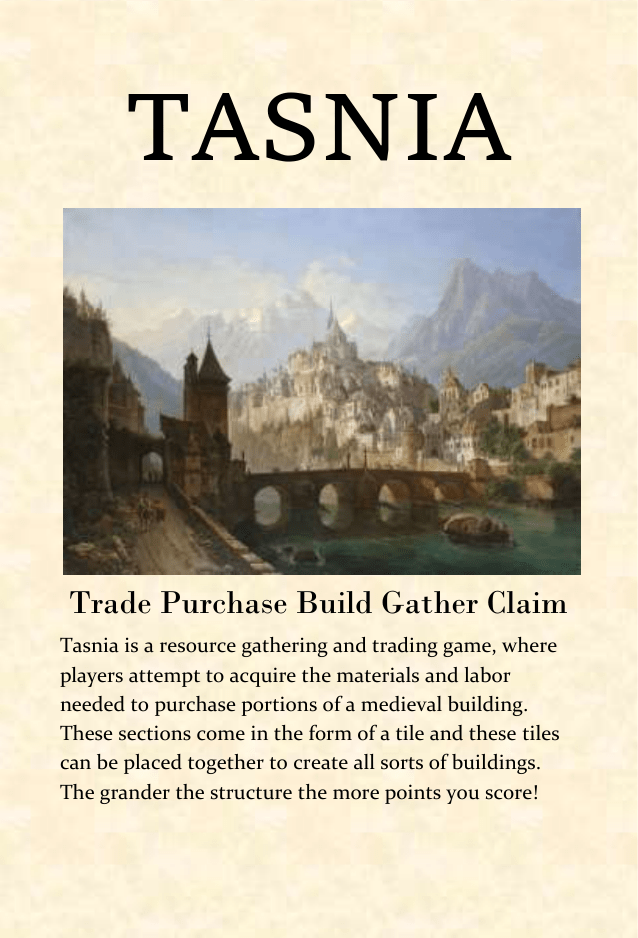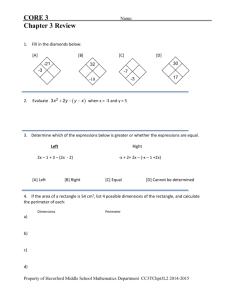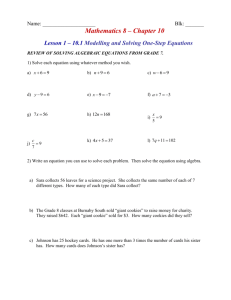
TASNIA
Trade Purchase Build Gather Claim
Tasnia is a resource gathering and trading game, where
players attempt to acquire the materials and labor
needed to purchase portions of a medieval building.
These sections come in the form of a tile and these tiles
can be placed together to create all sorts of buildings.
The grander the structure the more points you score!
Objective
Be the player to score the most points by completing
buildings using tiles and you will be crowned winner!
Components
81 - Resource Cards
72 - Building Tiles
4 - Jumbo Player Cards
4 – Wooden Player Tokens
Instruction Booklet
Box w/ Insert
Set up
1. Shuffle all 72 tiles and place them into 7 equal stacks of
10, face down, in the place were all players can reach.
Two of these stacks will contain 11 tiles.
2. Turn over the top tile in each stack.
3. Shuffle the deck of resource cards and deal 6 cards to
each player. Then place the remaining cards face down
in the place all can reach. If the resource deck is depleted
to zero during play, simply shuffle the discard and reuse.
4. Allow each player to select a player card and the token
that matches its color.
Playing the Game
Once the game is set up players take turns
starting with the player to the left of the dealer and then
continuing clockwise for the duration of the game. The
player’s turn is broken down into 5 phases and those
phases are:
1. Trade- The first thing a player does is trade in
unwanted resource cards for new cards if they so choose.
A player may always trade in a single card for a new card,
but if they want to trade in more than one card they
must trade in a group of cards of the same kind.
(Example: If you have 2 Iron cards you may trade in one of
them, or both, for 1-2 new card/s or if you have 4 Wood
cards, you may trade in 1-4 of them for new card/s.)
Players may only trade in 1 group of cards on any
given turn. This means a player may not turn in 1 Stone
and 3 Carpenters during the trade phase, they would
have to pick 1 card type to trade in.
2. Purchase. During this phase players may use their
resource cards to purchase tiles from the market. Each
tile requires 3 specific resource cards for purchase. The
requirements are noted as symbols in the top corner of
the tile. These symbols correspond to symbols on the
resource cards making the cost clear.
Above we have an image of a Tile (left) and a Resource
Card (right). This tile requires 1 stone (orange square), 1
iron (red triangle), and one Mason (blue M) to purchase.
The gold diamond indicates that this tile is unique and
worth an additional 2 points during scoring. This info is
indicated by the symbols in top left corner. The Master
Mason card is worth 2 resources (1 stone and 1
stonemason). A player may use this single card for two of
the needed resources to purchase the tile next to it.
However, you may not use a single card as part of a deal
involving more than one tile. Meaning, you cannot split
the two resources the Master Mason provides in order to
purchase two separate tiles.
Silver and Gold coins act as wild cards. Silver
may be used in place of any of the 6 resources and gold
may simply be used to purchase any one unclaimed tile.
The Baron, Hero, Merchant, and Princess cards
also act as a gold coin if a player does not want to play or
hold on to it. These cards are marked with a circle
symbol with 4 gold stars in the upper left corner to aid
players in distinguishing them.
Players may purchase 1 or more tiles on their
turn. There is no limit.
3. Building. With new tiles in hand, the player may
now add tiles to a structure in progress, add to a
completed structure to create an addition, start a whole
new structure altogether, or simply place the tile aside in
their stockpile for later use. Players may also move tiles
from one building to another if they so choose, but they
may not remove tiles from a completed building. Players
may also use tiles from their stockpile during this phase
to add to buildings or to start a new structure. Players
MUST follow the rules for building in the “Construction”
portion of the instructions.
4. Gather. During this phase of the turn, the player
simply gathers new cards from the draw pile in order to
bring their hand back up to the maximum. In most cases
this will always be 6 cards. If you have the Baron in play
you will draw 7. It is during this phase that you can play
the Money Lender Card and draw 3 additional cards or
play the Beggar Card and have each other player give you
one of their own cards.
5. Claim. During the final phase of the player’s turn
they may stake a claim on any unclaimed tiles. The
player simply places their colored wooden token on any
available tile in the market.
If a player wants to purchase a tile that has a claim on it,
they must pay full price plus one additional resource.
This additional resource must be one of the required
resources to purchase the tile. (ie. If a player wants to
purchase the wooden peak tile two pages back, and it was
claimed by another player, they would need to pay 2 wood,
1 carpenter, and either an additional wood or an additional
carpenter.
During the players next Purchase Phase if their
claimed tile has not been purchased by another player,
they may buy it with only 2 of the 3 needed resource
cards. This is a nice boon. Players may choose to use
claims in order to get tiles they need a bit cheaper, or
conversely they may use a claim to make another player
pay more for a tile that the other player needs. The
choice is entirely up to the player making the claim.
Construction
The rules laid out in this section inform the
players as to how they may construct a building and how
they may not construct a building.
Types of Tiles. Before we lay out the rules of
construction, it is important to become familiar with the
types of tiles. There are basically 2 types of tiles, wooden
and stone. Wood tiles include: wooden wall w/door,
wooden wall w/window, wooden roof left, wooden roof
right, and wooden peek. Stone tiles include: stone wall,
stone wall w/door, stone wall w/window, stone roof, and
tower peak. Lastly, there are the Garden Tiles. They have
their own separate rules.
Wood and Stone Together. Wooden tiles may be
placed on top of stone tiles, but may never be placed
under or beside them.
Roofs. No tile may be placed above, or next to, any
roof tile except the stone roof tile.
Wooden roof tiles must be placed so that rain
water would run off in both directions, meaning there
cannot be any places where water would gather. This
means that there may not be two or more peaks in a
single wooden structure.
Stone roofs may be placed side by side because
they have no pitch. Tower peaks must be placed on any
stone structure or portion of a stone structure that is 1
tile wide and more than 1 tile high.
Adding on to a Complete Building. During a
player’s build phase they may add on to a complete
building so long as they remove no tiles from it, and it
remains complete. This often entails adding 2 or more
tiles at once and shuffling a few as well. Basically, a
player cannot make a complete building an incomplete
building.
Building Height Restictions. Wooden Buildings
may only be 3 tiles high. Stone structures can reach as
high as 5 tiles. Buildings using both materials may also
not exceed 5 tiles in height.
Garden Tiles. Garden tiles may only be placed on the
ground level next to a completed building.
Other Building Guidelines.
A building may only have a single door.
A complete building may have as few as 2 tiles, and
there is no limit to the number of tiles you may use.
Construction of a building may start with any tile.
This means a player does not have to build from the
ground up.
There is no limit on the number of building a player
may construct during the course of the game.
Players may only add or remove tiles from their own
buildings.
Contruction Examples. On the next few pages are
some examples of buildings that follow the guidelines
and one that does not.
In the example above we have a larger house.
This home follows all the rules of the game. It is built of
all wooden tiles so there can be no issues with mixing
wood and stone. It has a single door. The roof has a
single peak and the roofline angles downward in both
directions allowing for rain runoff. It also does not
surpass the 3 tile height restriction for wooden
structures.
Here is another good example of a building. This
building uses both wood and stone in its construction.
Take note that the wood tiles are placed on top of the
stone and not under or on either side. The roof also
follows the guidelines by having a single peak that angles
downward in both directions.
In this example we have an all stone building
that appears to be a castle. Take note that the tower
peaks are placed on top of stone tiles that have no other
stone tile on either side. The three stone roof tiles across
the top in the middle are within the rules of
construction. Now if a player were to have attempted to
place both tower peaks without the stone tiles beneath
them, the structure would not be allowed as the bottom
of the peaks would be lower than stone roof tiles,
creating a place for rain to collect.
In this example almost everything is done wrong,
but it does help to illustrate what a player cannot do.
Let’s list all the things wrong with this example:
It has 2 doors but should only have one.
The wooden door is side by side with a stone
tile.
There is a roof tile touching the ground.
There is a stone roof tile on top of a wooden
door tile.
The tower peak tile is side by side with another
roof tile.
There is a wooden wall tile with a window on
top of a roof tile and it is also side by side with a
stone roof tile.
The wooden roof tiles allow for rain to collect as
there are two peaks.
In addition the wooden roof tile on the right has
the roof line moving upward.
Ending the Game
The game ends the moment that a certain number of
tile stacks are depleted.
A 2 player game ends when 1 stack is depleted.
A 3 player game ends when 2 stacks are
depleted.
A 4 player game ends when 3 stacks are
depleted.
When this occurs, all players get one more turn to
finalize their cities and the game comes to an end at the
end of the player’s turn to the right of the player who
drew the game ending tile. It is now time to score.
Scoring the Game
Players add up their scores for their completed
buildings, incomplete buildings, and tiles in their stock
pile by using the following guidelines.
Completed Buildings.
Scores for completed building are based on the
number of tiles used, size of the structure, and any
unique tiles involved. Here are the guidelines:
You gain 3 points for each tile used in the
completed building.
You gain an additional 2 points for every 4 tiles
in the building. This rewards players for building
large buildings.
Players also gain 2 extra points for each and
every unique tile used. These tiles are marked
with a yellow diamond symbol under their
required resources symbols.
Players also gain 4 bonus points for a garden tile
used on a completed building. However, garden
tiles not part of a structure have zero value.
Incomplete Buildings.
All incomplete buildings are worth 2 point for
each tile. Players only gain a 1 point bonus for each
unique tile.
Stockpile Tiles.
Stockpile tiles include all loose tiles that are not
part of any structure. These tiles are worth 1 point each.
Other Scoring Opportunities.
Players gain 1 bonus point for each silver
resource card in their hand.
Players gain 2 bonus points for each gold coin in
their hand.
Players gain 2 bonus points for each nonresource card in their hand
Special Cards
Tasnia comes with 6 special cards that a player
may draw from the resource deck. Players may decide to
use as many of these cards as they so choose in order to
alter the feel of the game. These cards alter play a bit by
giving special powers to a player or by hindering another
player. Some of these cards have special requirements
that must be met before they can be used. This can
equate to a player having to hold onto the card for a few
rounds and that can slow down their building by
clogging up their hand. Players can always use this card
to purchase any tile they want from the market. These 6
cards are marked with symbol with 4 stars in it to
indicate that they may be traded for any tile. However,
they risk another player getting that card later on during
the game.
Special cards can be moved from one building to
another during the Building Phase of the player’s turn.
At no point can one of these cards be housed in an
incomplete building. These cards also may be removed
from a building and placed into the discard pile during a
player’s purchase phase if the player wants to trade them
in for a tile.
All 6 of these cards must be played during the
build phase of the player’s turn.
Baron
Requirements - The Baron requires a home before a
player can make use of his powers. The player must have
a completed and uninhabited structure of 5 or more tiles
for him to live in. Once a player meets this requirement
he may place the Baron card on or below his new home
showing that it occupied by him.
Powers – The Baron allows the player to increase his
hand size from 6 cards to 7 cards.
Hero
Requirements – None
Powers – Players may place the Hero card on any
structure, even an incomplete structure, and he will
protect the building and any other person living there
from the Scoundrels card. The Hero does not count as an
inhabitant.
Merchant
Requirement – The Merchant requires a store to set up
shop in. This shop must be made of wood and be at least
4 tiles large. In addition, there must not be any other
inhabitants in the building. Players then place the
Merchant card on or below the building to indicate that
the building is occupied.
Powers – The Merchant allows players to treat silver
resource cards as gold resource cards.
Plague
Requirement – None
Powers – The Plague card can be used to remove another
player’s special card from play. This includes the Baron,
Merchant, and Princess. When used both cards are
placed into the discard pile.
Princess
Requirement – The Princess requires an all stone
structure to live in. This home must consist of 4 or more
tiles and must not have any other inhabitants. Players
then place the Princess card on or below the building to
indicate that the building is occupied.
Powers – The Princess card garners the player no powers
during play, but she instead adds value to any building
that houses her. Add an addition 1 point per tile during
scoring for any building that the Princess resides in.
Scoundrels
Requirement – None
Powers – Use the Scoundrels card to steal one tile from
another player. Then place the Scoundrels card into the
discard pile. If the scoundrels are used to remove a tile
from a building that is occupied, the occupant is placed
into the discard pile along with the Scoundrels card.
Bonus Kickstarter Cards. These cards are all
single use cards that are discarded at use. They also may
NOT be traded for a tile.
Alchemist – Players use this card during their purchase
phase to swap a tile from their stockpile for an
unclaimed tile in the market.
Beggar – Players use this card during their gather phase
and they force every other player to give them one card
from their hand. Every other player must fan out their
cards and the player who played the Beggar gets to
choose one card at random from each player.
Money Lender – Players use this card during their
gather phase by placing it into the discard pile and
drawing an additional 3 cards from the draw pile. These 3
additional cards are above and beyond the player’s
maximum hand size.
Tasnia is Copyright 2013 by Jason Glover. All rights
reserved. Grey Gnome Games
Visit us at GreyGnome.com or Like us on Facebook
or follow us on Twitter!









